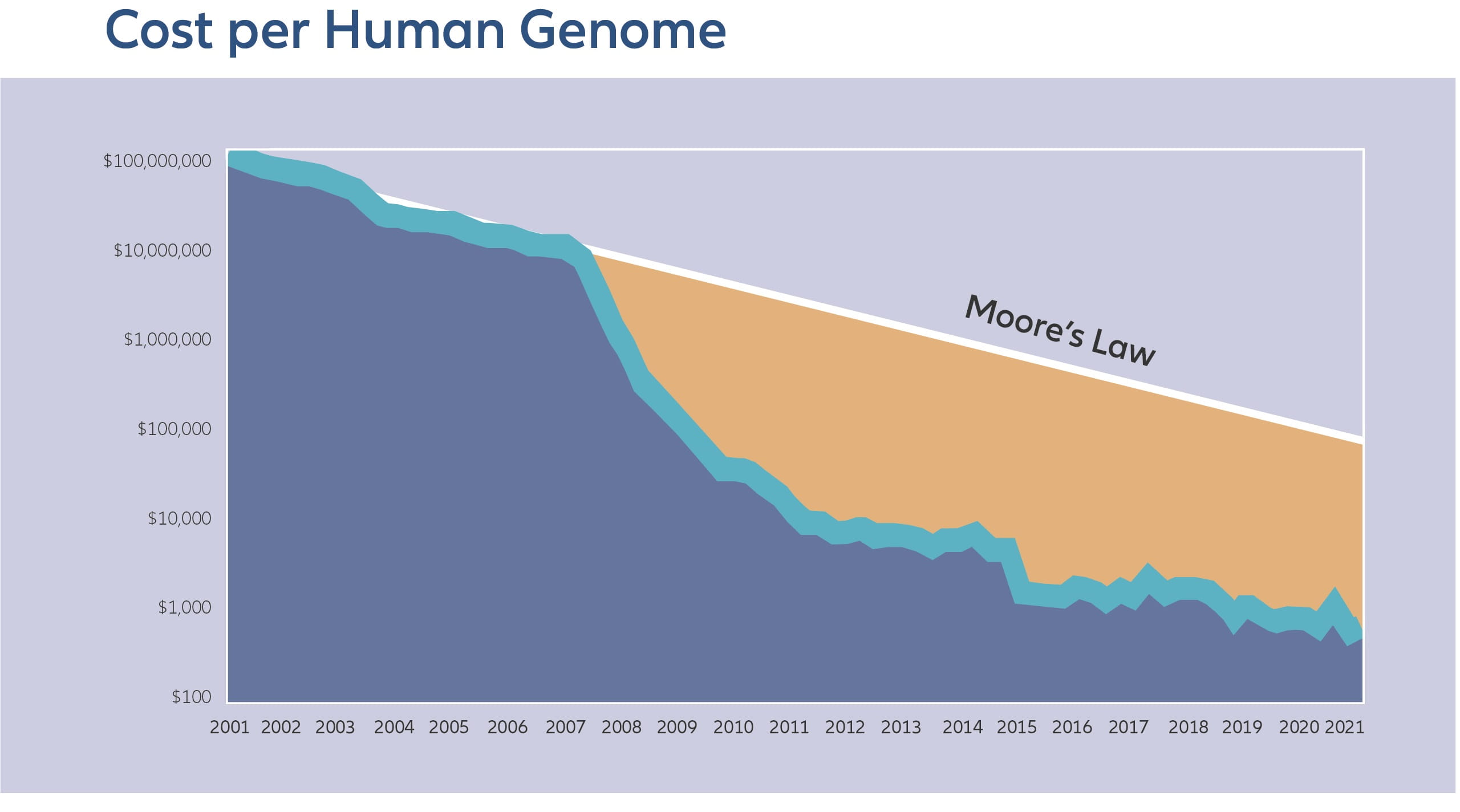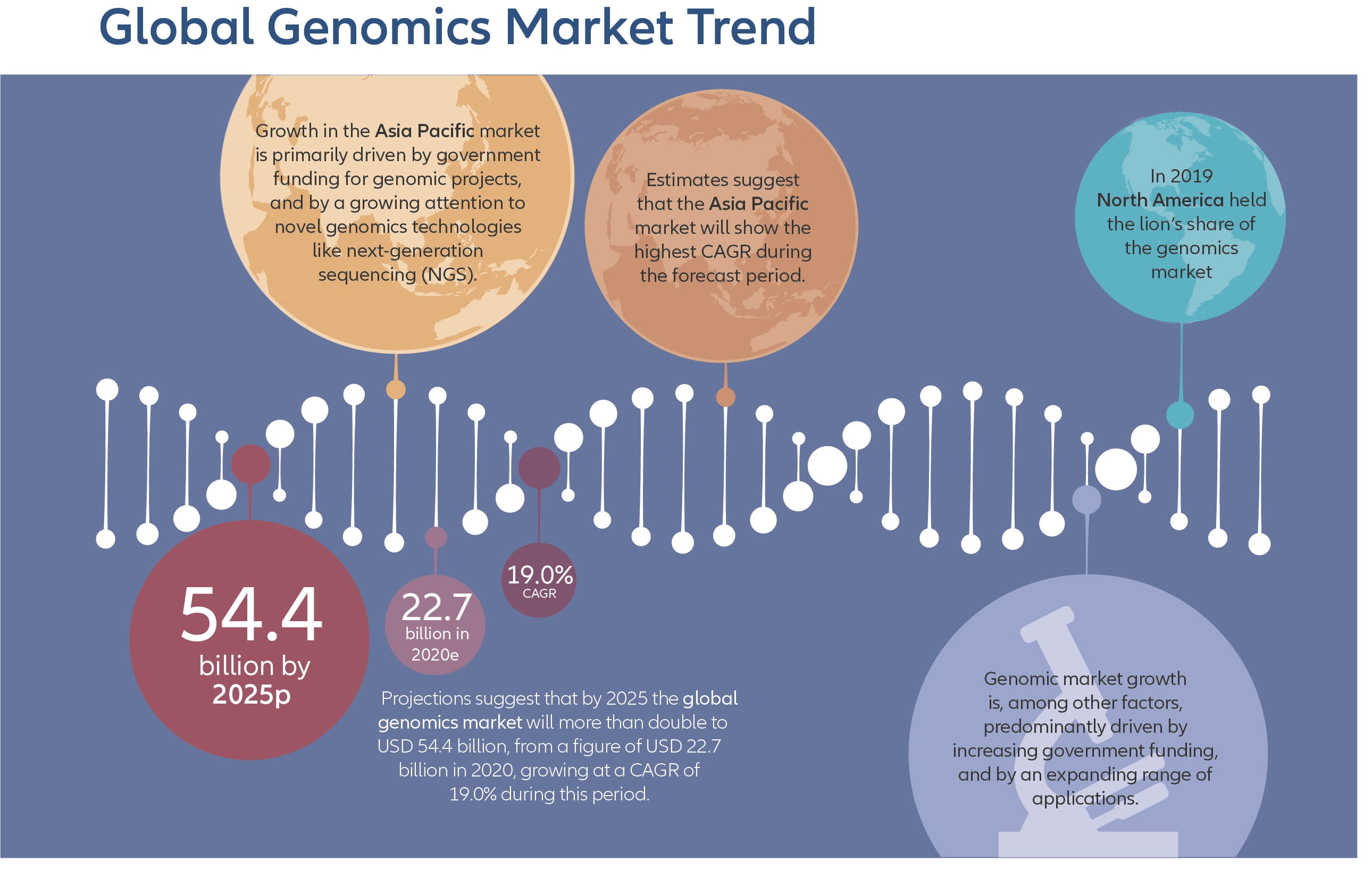
Summary
Since in 2003, the Human Genome Project (HGP) succeeded in sequencing and mapping the genome of homo sapiens, genomic sequencing has taken significant steps ushering in a new era of precision medicine and cost-effective personalized therapies. Find out how increasing application areas of genomic sequencing and declining costs per genome can offer opportunities to participate in the growth prospects of precision medicine and health innovation.
Key takeaways:
- In 2003, the Human Genome Project (HGP) completed and published the full sequence of the entire human genome, a tipping point in the Genomic revolution.
- Since then, genomic sequencing has gained great significance in the research and development of personalized/precision medicine, as well as other therapeutics and vaccines, contributing decisively to the understanding and mapping of the SARS-CoV-2 virus and its variants and to the development of vaccines in record time.
- Cost-effective personalized therapies facilitate the identification of patients’ exact needs and the prescription of individualized medicines and treatments.
- Increasing application areas of genomics offer the opportunity to participate in the growth prospects of precision medicine.
- According to estimates, the global genomics market could reach USD 54.4 billion by 2025, driven by a double-digit growth rate during the next five years.
Summary
- In 2003, the Human Genome Project (HGP) completed and published the full sequence of the entire human genome, a tipping point in the Genomic revolution.
- Since then, genomic sequencing has gained great significance in the research and development of personalized/precision medicine, as well as other therapeutics and vaccines, contributing decisively to the understanding and mapping of the SARS-CoV-2 virus and its variants and to the development of vaccines in record time.
- Cost-effective personalized therapies facilitate the identification of patients’ exact needs and the prescription of individualized medicines and treatments.
- Increasing application areas of genomics offer the opportunity to participate in the growth prospects of precision medicine.
- According to estimates, the global genomics market could reach USD 54.4 billion by 2025, driven by a double-digit growth rate during the next five years.
How genomic sequencing scales up health innovation
In 2003, the Human Genome Project (HGP) succeeded in sequencing and mapping the genome of homo sapiens. This tipping point in the Genomic revolution not only gave the birth to genomic sequencing as a new and fascinating research area, but also ushered in a new era of precision medicine and personalized treatments.
|
"[…] it's a transformative textbook of medicine, with insights that will give health care providers immense new powers to treat, prevent and cure disease." |
Since then, genomic sequencing has taken significant steps, enabling scientists to classify and characterize viral samples and thus significantly contributing to the development of vaccines in record time with the help of genome engineering tools, among other things. It is indeed undeniable how important genetic epidemiology research has been in containing the COVID-19 pandemic.
Similarly, gene sequencing has many other important applications such as facilitating the screening for early detection and treatment of diseases. Together with other gene-editing technologies and high-precision DNA synthesis platforms, it helps to modify, delete or correct precise DNA regions and accelerate research and discovery. For example, together with other technologies like artificial intelligence, gene sequencing can have an enormous impact on clinical trials, helping to reduce failure rates and shorten the time to market for many essential drugs.
Deciphering a gene’s superpower
|
"In 2025, as many as 2 billion people could have their genomes sequenced." |
The archetypical conflict between good and evil is not only played out in cinematic settings, but also in the depth of our DNA. For a long time, geneticists focused on deciphering the code of disease-provoking genes and their variants and/or mutations. However, with the discovery of genes having the opposite, healing effect, the way was paved for the development of medication and treatments that could imitate or simulate the impact of disease-protecting genes. The discovery and “re-modeling” of these “superpower genes” was particularly accelerated by the possibility to timely sequence the genomes of millions of participants in globally conducted studies. This joining of research capabilities enabled scientists to significantly speed up the uncovering of several protective gene variants and to create disease inhibitors with a similar protective effect like their genetic role models while also preparing the ground for precision and personalized medicine.
Personalized Medicine: the blueprint for sustainable health
Our genes form the foundation and basis of human health. They are key in determining, for example, if one is at an increased risk of developing certain conditions or of suffering from inherited health problems.
The better we understand our unique genetic makeup the more additional valuable information we can gain. This knowledge can help to:
- develop and prescribe tailor-made medical care perfectly matching not only the genetic makeup but also the actual health status of an individual patient.
- significantly reduce potential side effects.
- benefit from better outcomes and a more effective treatment.
- predict more accurately the individual response of a given treatment.
- avoid taking additional tissue or blood samples
- develop tailor-made prevention strategies for specific diseases in accordance with the corresponding genetic disposition
- adapt the frequency of screenings to prevent or diagnose and treat diseases earlier.
- change our lifestyle meticulously
- guide decision-making surrounding our health through all stages of life.
|
"1 in 6 healthy adults is at increased risk for a serious health condition due to their genetics—and probably doesn't know it." 3 |
Despite the controversy on the (future) role of secondary genomic findings, they are a crucial part of the progress that genomics is making in helping us care for our health. ! It is putting the power in our hands to more effectively guide our treatment options – be it in cancer care, heart disease, pregnancy etc., by finding the precise method of care needed as dictated by our genes. Less cookie-cutter treatments and more tailor-made solutions can make for a more robust and effective healthcare system where the consumer feels empowered, confident, and hopeful. Knowing that physician recommendations were guided by our unique genetic makeup resulting in a personalized health plan paves the way for more sustainable health and can only continue to grow by leaps as we further our research in this area of genomics.
Are the costs for genetic sequencing following Moore’s Law?
Following recent estimates on the cost trend for genomic sequencing, the rate of cost decline seems to not only follow but also exceed Moore’s law as costs have approximately halved every two years. If this pattern is maintained, the cost per genome will soon fall below USD 1,000.

Source: https://www.genome.gov/about-genomics/fact-sheets/Sequencing-Human-Genome-cost, 2021
This decline in costs is contrasted by the considerable growth of the global genomics market, with forecasts predicting the segment to reach a value of USD 54.4 billion, a double-digit CAGR-growth of 19.0% by 2025.4

e = estimated | P = projected. Source: MarketsandMarkets.com
The genomic sequencing market is ripe with opportunity for investors. With the rise of more viral diseases globally, the declining costs of genomics which would allow for more personalized treatments as well as significant investment from governments and companies, we will continue to see major growth. With genomic sequencing becoming less costly and more areas for application becoming more available, there will be greater and more sustainable opportunities for specialized companies.
Allianz Global Investors identifies genomic sequencing innovators
To further accelerate the genomic sequencing research and to widen its application areas, investments are needed. Redirecting capital flow towards key enablers helps to develop and refine personalized-medicine solutions that offer more individualized time- and cost-effective treatments options while at the same time reducing side-effects risks.
Allianz Global Investors continues to identify innovators specialized in the detection of disease-provoking genes as well as the improvement and the acceleration of conventional drug development processes. This offers investors not only opportunities to participate in growth prospects but also to contribute to the development of a more robust and effective healthcare system.
Find out more about sustainable investment at Allianz Global Investors here:
1 https://www.genome.gov/10001379/february-2001-working-draft-of-human-genome-director-collins
2 Haverfield E, Esplin ED, Aguilar S, et al. Multigene panel screening for hereditary disease risk in healthy individuals. Poster presented at: ACMG Annual Meeting; April 12, 2018; Charlotte, NC.
3 https://www.genome.gov/news/news-release/from-one-genomic-diagnosis-researchers-discover-other-treatable-health-conditions
4 https://www.marketsandmarkets.com/Market-Reports/genomics-market-613.html
Investing involves risk. The value of an investment and the income from it will fluctuate and investors may not get back the principal invested. Investing in the water-related resource sector may be significantly affected by events relating to international political and economic developments, water conservation, the success of exploration projects, commodity prices and tax and other government regulations. Past performance is not indicative of future performance. This is a marketing communication. It is for informational purposes only. This document does not constitute investment advice or a recommendation to buy, sell or hold any security and shall not be deemed an offer to sell or a solicitation of an offer to buy any security. The views and opinions expressed herein, which are subject to change without notice, are those of the issuer or its affiliated companies at the time of publication. Certain data used are derived from various sources believed to be reliable, but the accuracy or completeness of the data is not guaranteed and no liability is assumed for any direct or consequential losses arising from their use. The duplication, publication, extraction or transmission of the contents, irrespective of the form, is not permitted. This material has not been reviewed by any regulatory authorities. In mainland China, it is used only as supporting material to the offshore investment products offered by commercial banks under the Qualified Domestic Institutional Investors scheme pursuant to applicable rules and regulations. This document does not constitute a public offer by virtue of Act Number 26.831 of the Argentine Republic and General Resolution No. 622/2013 of the NSC. This communication’s sole purpose is to inform and does not under any circumstance constitute promotion or publicity of Allianz Global Investors products and/or services in Colombia or to Colombian residents pursuant to part 4 of Decree 2555 of 2010. This communication does not in any way aim to directly or indirectly initiate the purchase of a product or the provision of a service offered by Allianz Global Investors. Via reception of his document, each resident in Colombia acknowledges and accepts to have contacted Allianz Global Investors via their own initiative and that the communication under no circumstances does not arise from any promotional or marketing activities carried out by Allianz Global Investors. Colombian residents accept that accessing any type of social network page of Allianz Global Investors is done under their own responsibility and initiative and are aware that they may access specific information on the products and services of Allianz Global Investors. This communication is strictly private and confidential and may not be reproduced. This communication does not constitute a public offer of securities in Colombia pursuant to the public offer regulation set forth in Decree 2555 of 2010. This communication and the information provided herein should not be considered a solicitation or an offer by Allianz Global Investors or its affiliates to provide any financial products in Brazil, Panama, Peru, and Uruguay. In Australia, this material is presented by Allianz Global Investors Asia Pacific Limited (“AllianzGI AP”) and is intended for the use of investment consultants and other institutional/professional investors only and is not directed to the public or individual retail investors. AllianzGI AP is not licensed to provide financial services to retail clients in Australia. AllianzGI AP (Australian Registered Body Number 160 464 200) is exempt from the requirement to hold an Australian Foreign Financial Service License under the Corporations Act 2001 (Cth) pursuant to ASIC Class Order (CO 03/1103) with respect to the provision of financial services to wholesale clients only. AllianzGI AP is licensed and regulated by Hong Kong Securities and Futures Commission under Hong Kong laws, which differ from Australian laws. This document is being distributed by the following Allianz Global Investors companies: Allianz Global Investors U.S. LLC, an investment adviser registered with the U.S. Securities and Exchange Commission; Allianz Global Investors Distributors LLC, distributor registered with FINRA, is affiliated with Allianz Global Investors U.S. LLC; Allianz Global Investors GmbH, an investment company in Germany, authorized by the German Bundesanstalt für Finanzdienstleistungsaufsicht (BaFin); Allianz Global Investors (Schweiz) AG; Allianz Global Investors Asia Pacific Ltd., licensed by the Hong Kong Securities and Futures Commission; Allianz Global Investors Singapore Ltd., regulated by the Monetary Authority of Singapore [Company Registration No. 199907169Z]; Allianz Global Investors Japan Co., Ltd., registered in Japan as a Financial Instruments Business Operator [Registered No. The Director of Kanto Local Finance Bureau (Financial Instruments Business Operator), No. 424, Member of Japan Investment Advisers Association and Investment Trust Association, Japan]; and Allianz Global Investors Taiwan Ltd., licensed by Financial Supervisory Commission in Taiwan.
AdMaster: 1911094 | LDS-211226

Summary
Physical and economic water scarcity have both drastic societal and economic effects. An increasing (urban) population with a growing demand for food, climate change causing more extreme weather and an aging infrastructure are the main drivers for water scarcity and water stress. Water scarcity is a significant barrier to economic growth, not only in already water-scarce regions








